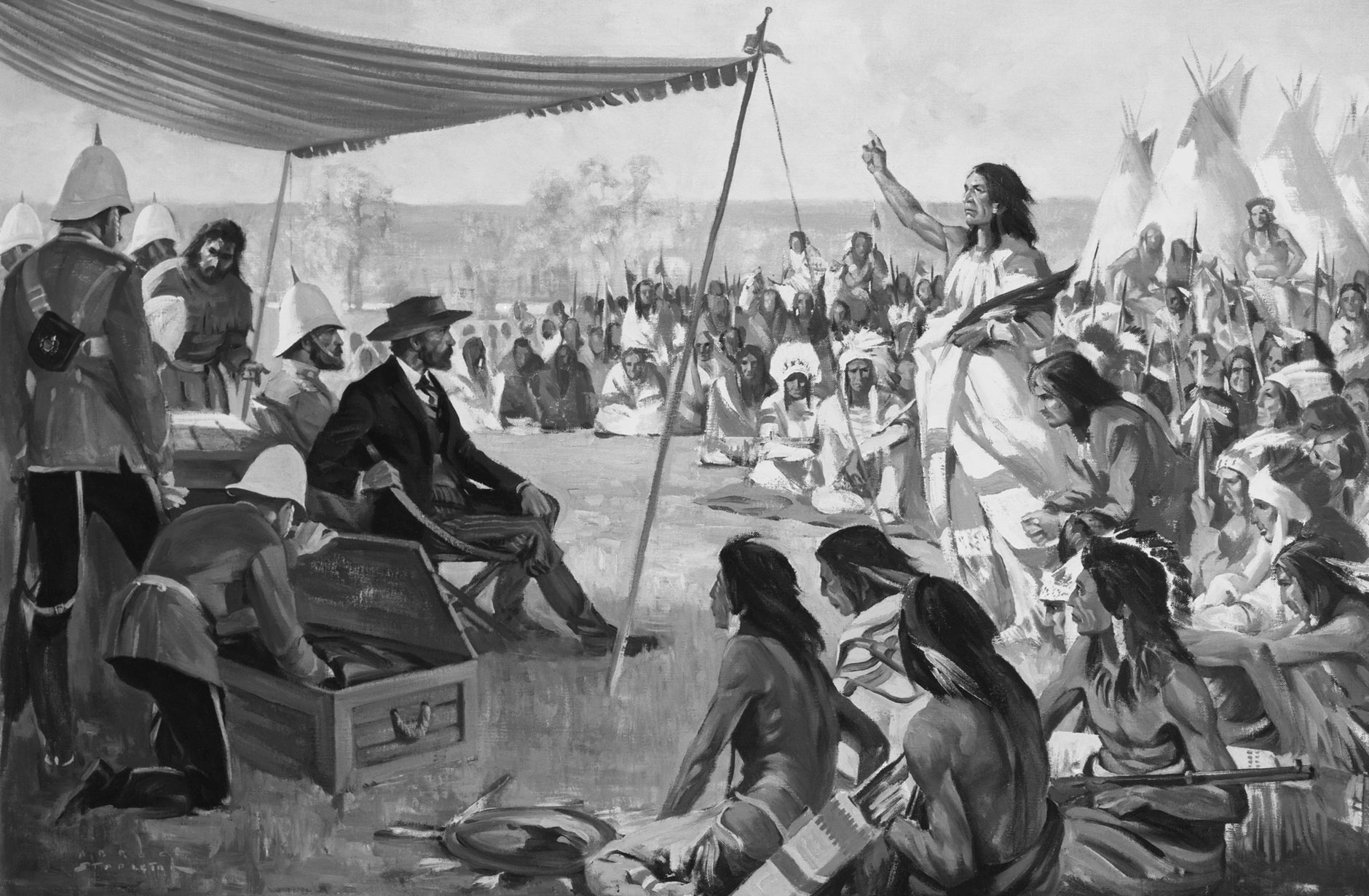Canada’s claim to many Indigenous territories still hinges on a “surrender clause” in treaty texts. No Surrender: The Land Remains Indigenous, a recently published book from the University of Regina Press, uncovers the details of a Crown negotiating strategy to bury the surrender clause in treaty negotiations.
Taking direction from Indigenous nations’ work documenting their oral treaty histories, author Sheldon Krasowski, a non-Indigenous historian at Athabasca University, finds that long-neglected written sources from the negotiations consistently substantiate Indigenous perspectives on treaty terms.
The texts of Treaties One through Seven, negotiated between 1871 and 1877, each contain this templated clause stating signatory nations would “cede, release, surrender, and yield up” their lands.
Oral histories and laws of Indigenous nations who negotiated these treaties (Cree, Anishinaabe, Saulteaux, Nakoda, Siksika, Piikani, Kainai, Stoney and Tsuu T’ina, who had been negotiating treaties long before Treaty One) state the treaties were not land surrenders but agreements to share their vast territories for specific uses — broadly, settlement and farming — in exchange for agreed provisions and protections.
For decades, white non-Indigenous scholars attributed contrasting treaty histories to “cultural misunderstanding” on the part of Indigenous people, framed as unwitting signatories. This is, at worst, a blatantly racist thesis that requires an explicit challenge.
“With the exception of the surrender clause, the treaty benefits for both Indigenous Peoples and Euro-Canadians were clearly acknowledged during the treaty-making period,” Krasowski writes. How could the overarching principle of surrender be missing from the record of those supposedly surrendering their lands?
Krasowski’s debut book examines original manuscripts, eyewitness accounts and other primary documents outside Canada’s official record to meticulously argue treaty terms were negotiated (not handed down) and mutually understood; surrender was not among them.
The author outlines a consistent and strategic effort from treaty commissioners to negotiate the benefits of treaty while ignoring the liabilities for Indigenous nations, particularly with regards to land use, governance and reserves. On the fickleness of treaty terms regarding land, Krasowski highlights a precedent treaty establishing “reserves” as restricted agricultural areas for settlers.
Comparison between official reports and eyewitness accounts is a key strength of Krasowski’s argument, offering compelling contradictions which show Indigenous nations to be active negotiating partners and convincingly suggest surrender was not discussed during negotiations.
For example, the official record of Treaty Six includes a commissioner’s speech outlining treaty terms including surrender that was not recorded by eyewitnesses, while omitting a strong rebuke from Cree leader (later Chief) Poundmaker, who explicitly asserted: “This is our land.” Poundmaker was posthumously exonerated for fabricated treason charges in May of this year, which certainly supports Krasowski’s argument of Canadian duplicity.
Other government tactics to avoid discussing surrender while putting it on paper include strategically editing official records from the original manuscripts, focusing on detailed negotiations in other areas (annuities, agricultural supplies, etc.) and employing favourable interpreters, Krasowski finds.
In exposing these tactics, Krasowski’s research prompts urgent questions on Canada’s negotiating strategy with Indigenous nations today, claiming to have Indigenous consent or agreement for the ongoing appropriation of Indigenous lands and resources. In particular, we can ask: How is the false assumption of “surrender” influencing today’s treaties, agreements, and the interpretation of responsibilities?
Despite the promoted wide-reaching relevance of its findings to the Canadian public, No Surrender remains staunchly academic. Coming in at an exhaustive 368 pages with notes and appendix, the book follows a standard historical survey format (plenty of names, dates, chronological order), packed with details whose relevance is not always clear.
Still, the size and density correspond with the book’s ambitious goal to challenge Canada’s fundamental claims to land through its own archives — making it hard to argue with the thoroughness of the research — and it is sure to be an important reference and tool for academics, lawyers, activists and community members alike.
Ultimately the subtitle (“the land remains Indigenous”) is more decisive on land ownership and intent to deceive than Krasowski’s measured conclusions, which affirm shared rights and responsibilities under treaty but fall short of mentioning land return. He states that at the least, “the absence of the surrender clause during the discussions casts doubt on the validity of the complete surrender of Indigenous lands.” Because of this scholarly remove, the current political implications of Canada’s deception and the land being Indigenous remain elusive, and it’s not clear to the reader exactly how the findings are meant to spur political and societal shifts as advertised.
No Surrender is a welcome thorn in the side of Canada’s claims to Indigenous lands and powerfully challenges the sanctity of the official written record. But we should question why it is still necessary to defend — in settler terms — what Indigenous nations have been saying since the first unfulfilled treaty promises.
Canada and Canadians need to take Indigenous nations at their own word that surrender is not the basis of this country.
Image: “Treaty Number Seven,” painting by Bruce A. Stapleton. Chief Crowfoot addresses Commissioner David Laird seated at the centre and Commissioner James Macleod seated to his left. Jean L’Heureux stands beside Macleod. Source: Saskatoon Public Library Local History Room/Glenbow-Alberta Archives, NA-40-1
Sarah Boivin is a settler researcher, writer, editor and anti-racist educator from Algonquin territory. She holds a Master’s in Indigenous Governance from the University of Victoria.
Make rabble sustainable. Please consider supporting our work with a monthly donation and join us as we take on the 2019 election. Support rabble.ca today for as little as $1 per month!




